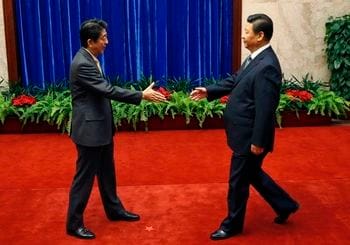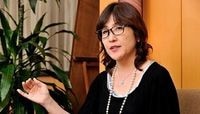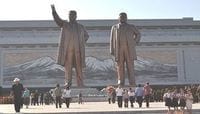
Chinese head of state Xi Jinping extended his hand expressionlessly as Prime Minister Shinzo Abe approached with a grimace. Xi did not look Abe in the eyes once during their extended handshake.
Abe, in China for the APEC (Asia-Pacific Economic Cooperation) summit, met privately with Xi in the afternoon of November 10 at the National People's Congress building, the first formal meeting between Chinese and Japanese heads of state since Prime Minister Yoshihiko Noda's visit to China in December 2011.
The CCTV (China Central Television) news that night featured long-winded reports on the Chinese head of state's talks with various foreign dignitaries. The report on Xi's talk with the Japanese prime minister came only after six other nations were reported on, directly after Papua New Guinea. After a few seconds of video of the ill-fated handshake, the visual switched to a male news announcer reading from the Chinese government’s press release.
Two Preconditions To Make Meeting Happen
China, wary of the reaction within its own country, showed signs of nervousness about handling the talks this time, a testimony to how precarious the relationship of trust between China and Japan has become.
After saying “The peaceful development of China is desirable for both the international community and for Japan,” Abe stated, “My thoughts on the Sino-Japanese relationship have not changed at all since my last visit in October 2006, and we should at this juncture return to the starting point of rebuilding a mutually beneficial strategic relationship.”
The private talks between Xi and Abe came close to not happening at all. The general assumption on the street was that China as the APEC host would have to at least manage an informal chat with Japan. However, China allegedly set preconditions before it would open the formal talks; the first, Japan had to acknowledge the existence of the territorial dispute between China and Japan over the Senkaku/Diaoyu Islands, and the second, Abe had to indicate that he would not visit Yasukuni Shrine going forward.
Either one was hard to accept for the Japanese prime minister, who had been demanding "a summit without preconditions". It looked like there were major obstacles to reconciling the situation to the point that talks could happen.
The break in the impasse came about when China and Japan, concerned about public opinion in their own countries, settled for ambiguity. The four points agreed upon by both nations for announcement on the day before the summit opened reflect the situation, having been wrapped up on that very day by Japan’s National Security Advisor Shotaro Yachi and top Chinese diplomat State Councilor (Deputy Minister class) Yang Jiechi.
The two key points spelled out in the four-point agreement were 1) somewhat of a consensus on recognition of political hurdles impacting relations between the nations that need to be overcome, and 2) recognition that both sides have different views of the tense situation continuing over recent years concerning East China Sea islands including the Senkaku/Diaoyu Islands.
The first point addresses the problem of the perception of history that is represented by Yasukuni Shrine, and the second, China's demand for acceptance of the existence of a territorial dispute. Yet the extreme ambiguity of the expression of these points of agreement is such that each nation can still tell their own people that they have not made any concession toward the other.
This situation conjures up the last visit to China by the Japanese government, which was during the first Abe administration in October 2006. The sticking point then was whether Abe would carry on making visits to Yasukuni Shrine as Junichiro Koizumi had continued to do during his tenure as Prime Minister.
At the time, in answer to then president Hu Jintao's statement that "visits to Yasukuni Shrine are emotionally hurtful to the people of China and Asia and damaging to the political foundation of Sino-Japanese relations," Abe professed that he would "not say if I will visit or not." He then called for a complete rebooting of relations based on the keywords "mutually beneficial strategic relationship."
The posture adopted was to ride out the controversy using the tactic of ambiguity in order to speed the restoration of relations. In control of the advance negotiations with China at the time was none other than then-Vice Minister of Foreign Affairs Shotaro Yachi.
Then-President Hu had just defeated his arch political enemy and CPC Shanghai Committee Secretary Chen Liangyu the month before, and was in a position of strength, able to quash Chinese criticism of him as being "soft on Japan." This situation led up to President Xi making the announcement this past July of investigations into Zhou Yongkang former Central Politburo Standing Committee member, making it known to the world and his constituents the solidity of his administration's footing. As a setting enabling China's leadership to take the risk of approaching Japan, the situation right now feels a lot like 2006.
Buying Time Has Its Limits
Both sides agreed during the talks this time to creating marine communication mechanisms in order to avoid conflict or collision in the East China Sea, and that dialogue between the heads of state has been reopened is noteworthy. It may well be the case that "This means business with Japan is open. It will now be easier for the Chinese government and the Chinese people to work together with Japan," (top METI official).
However, it remains to be seen whether China-Japan relations will really improve going forward. The big difference between eight years ago and now is the change in the relationship between China and Japan. The size of the economies of China and Japan reversed position in 2010, and by 2013 the Chinese nominal GDP was double that of Japan's. Over the last eight years Japan's share of the Chinese export/import market has fallen drastically. This type of change is making China's position vis-a-vis Japan ever more self-assured. Japan needs a well-thought-out plan for rebuilding its relationship with China. The tactic of ambiguity is really just a way to buy time.




